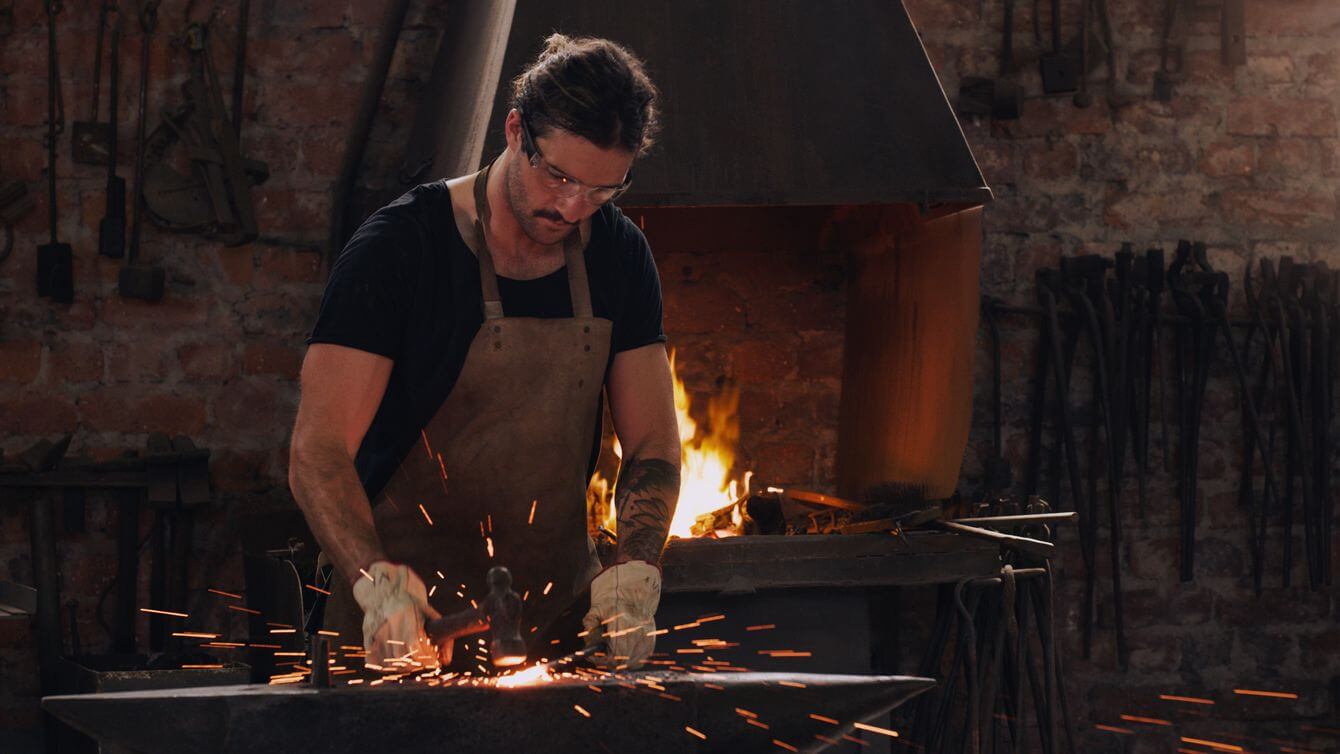
Blacksmithing is a time-honored craft that has been practiced for centuries. It is a skill that involves shaping and manipulating metal through heating, hammering, and forging, creating objects of both functionality and beauty. From horseshoes to swords, blacksmiths have played a crucial role in shaping history.
In this article, we will explore 20 astonishing facts about blacksmiths and their craft. From their role during the Industrial Revolution to their use of traditional techniques in the modern era, blacksmiths continue to leave a lasting impact on society. So, if you are intrigued by the art of blacksmithing or simply curious to learn more, buckle up and prepare to be amazed by the fascinating world of blacksmiths.
Key Takeaways:
- Blacksmithing is an ancient craft that dates back thousands of years and has played a crucial role in shaping civilizations. Blacksmiths were highly respected members of society and were crucial to the development of weapons and armor.
- Blacksmithing is both an art and a science, requiring physical strength, patience, and attention to detail. The craft continues to inspire and captivate, with a resurgence in modern times and a global appeal.
The ancient art of blacksmithing dates back thousands of years.
Blacksmithing, one of the oldest and noblest professions, can be traced back to ancient civilizations such as the Greeks, Romans, and Egyptians. This age-old craft has stood the test of time, evolving and adapting over centuries.
The term “blacksmith” comes from the color of the metal.
Contrary to popular belief, the term “blacksmith” does not refer to the color of the smith’s skin or clothing. Instead, it derives from the black oxide coating that forms on the metal during the forging process.
Blacksmiths were highly respected members of society.
In medieval times, blacksmiths held a revered position in society. Their skills were in high demand, and they were often regarded as indispensable members of their communities. Their work contributed to the advancement of technology and played a crucial role in shaping civilizations.
Blacksmiths were crucial to the development of weapons and armor.
Blacksmiths played a vital role in forging weapons and armor throughout history. They were responsible for crafting swords, shields, helmets, and other essential tools of war. Their expertise in metalworking ensured the durability and effectiveness of these weapons on the battlefield.
Blacksmiths were often associated with supernatural powers.
Due to their remarkable ability to transform raw metal into functional objects, blacksmiths were often seen as possessing supernatural powers. In many mythologies and folklores, they were believed to have control over fire, metal, and even the weather.
Horseshoeing is a specialized skill of blacksmiths.
While blacksmiths are skilled in various forms of metalworking, they are particularly renowned for their ability to forge horseshoes. Horseshoes are carefully designed and shaped to provide support and protection to horses’ hooves.
Blacksmithing is both an art and a science.
Blacksmithing requires a unique combination of artistic creativity and technical knowledge. From creating intricate designs to understanding metallurgy and heat treatment, blacksmiths possess a wide range of skills that combine both artistry and science.
The blacksmith’s forge is the heart of the workshop.
The forge, where metal is heated and shaped, is the centerpiece of a blacksmith’s workshop. It consists of a coal or gas-fueled fire, an anvil, and various tools that enable the blacksmith to manipulate the metal with precision.
Blacksmithing is experiencing a resurgence in modern times.
Despite the advent of industrialization, blacksmithing has experienced a resurgence in recent years. Many individuals are rediscovering the joy of working with their hands and the satisfaction of creating unique, handmade pieces through the ancient craft of blacksmithing.
Blacksmiths use various tools to shape and manipulate metal.
Blacksmiths utilize a wide array of specialized tools to bend, cut, and shape metal. These tools include hammers, tongs, chisels, anvils, and vices, each serving a specific purpose in the blacksmithing process.
Blacksmithing requires physical strength and endurance.
The art of blacksmithing is physically demanding. Blacksmiths often have to exert significant force to shape the metal, requiring both strength and endurance to withstand the rigors of their craft.
Traditional blacksmithing techniques are still practiced today.
While modern technology has introduced new methods and materials to metalworking, many blacksmiths continue to honor traditional techniques. This dedication to preserving the old ways ensures that the art of blacksmithing remains rooted in its rich history.
Blacksmiths create both functional and decorative pieces.
Blacksmiths are skilled in crafting objects that serve both practical and aesthetic purposes. From practical tools and hardware to ornate sculptures and decorative items, their creations showcase the versatility and artistry of their trade.
Blacksmithing requires patience and attention to detail.
Blacksmithing is not a rush job. It demands patience and meticulous attention to detail. Every strike of the hammer and each twist of the metal requires careful precision to achieve the desired outcome.
Blacksmithing is a global craft.
Blacksmithing is not limited to a specific region or culture. It is a craft that has been practiced across the globe in various forms, showcasing the universal appeal and importance of metalworking throughout history.
Blacksmiths play a role in historical reenactments.
Blacksmiths often participate in historical reenactments, bringing the past to life by demonstrating traditional techniques and showcasing the tools and equipment used by blacksmiths in different eras.
Blacksmiths can transform scrap metal into works of art.
Blacksmiths have a unique ability to take discarded or scrap metal and transform it into beautiful works of art. Their creativity and skill turn seemingly worthless materials into valuable and visually stunning pieces.
Blacksmithing requires an understanding of metallurgy.
Knowledge of metallurgy is essential for blacksmiths. Understanding the properties and behavior of different metals allows them to select the appropriate materials and apply the most effective techniques in their craft.
Blacksmiths learn through apprenticeships and hands-on experience.
Blacksmithing is often passed down through generations or taught through apprenticeships. Learning from experienced blacksmiths and gaining hands-on experience is a crucial part of mastering the art of forging metal.
The art of blacksmithing continues to inspire and captivate.
The ancient and fascinating art of blacksmithing continues to inspire generations of craftsmen and enthusiasts alike. The combination of skill, creativity, and the sheer power of transforming raw metal into functional and beautiful objects makes blacksmithing truly astonishing.
Conclusion
Blacksmiths have played a significant role throughout history, combining artistry with craftsmanship to create beautiful and functional metalwork. Their skills and dedication to their craft are truly astonishing. From forging weapons to creating intricate decorative pieces, blacksmiths have made an indelible impact on society.
These 20 astonishing facts about blacksmiths shed light on their incredible history and the valuable contributions they have made. From their ancient origins to the modern resurgence of interest in the art of blacksmithing, it is clear that the legacy of blacksmiths will continue to inspire and captivate for years to come.
Whether you have a deep appreciation for blacksmithing or are simply intrigued by the craft, the world of blacksmiths offers a glimpse into a fascinating world of skill and creativity.
FAQs
1) What is a blacksmith?
A blacksmith is a skilled artisan who works with metal, forging and shaping it into various objects using heat and tools.
2) How long does it take to become a blacksmith?
Becoming a proficient blacksmith can take several years of practice and training. It requires learning various techniques, understanding different types of metals, and developing a strong sense of craftsmanship.
3) What tools does a blacksmith use?
A blacksmith typically uses tools such as a forge, anvil, hammer, tongs, and various shaping and cutting tools to manipulate and shape the metal.
4) Can anyone become a blacksmith?
While anyone can try their hand at blacksmithing, becoming a skilled blacksmith requires dedication, patience, and a passion for the craft. It is a physically demanding profession that requires practice and a commitment to honing one’s skills.
5) What kind of objects can a blacksmith make?
A blacksmith can create a wide range of objects, including weapons, armor, decorative items, tools, and even furniture. The possibilities are endless, limited only by the blacksmith’s imagination and skill.
6) Is blacksmithing still relevant today?
While blacksmithing has evolved over time, it remains relevant today. Many blacksmiths continue to practice the traditional craft, while others incorporate modern techniques to create unique and contemporary metalwork.
7) Can I learn blacksmithing as a hobby?
Absolutely! Blacksmithing can be a fulfilling hobby for those interested in working with metal and creating objects by hand. There are often local blacksmithing classes and workshops available for beginners to learn the basics.
8) Where can I see the work of blacksmiths?
Blacksmiths often showcase their work at local art galleries, craft fairs, and even historical reenactments. Additionally, many museums exhibit historical pieces created by blacksmiths.
9) How do blacksmiths heat the metal?
Blacksmiths typically heat the metal using a forge, which is a specially designed furnace where the metal can be heated to high temperatures.
10) Are blacksmiths considered artists?
Yes, blacksmiths are often considered both craftsmen and artists, as their work requires technical skill as well as creativity and artistic vision.
Blacksmithing's rich history and modern resurgence captivate enthusiasts worldwide. Delving deeper into this ancient craft, you'll find even more extraordinary facts about blacksmithing that showcase its enduring legacy. For those curious about the science behind metalworking, exploring facts about molten metals will provide fascinating insights. And no discussion of blacksmithing would be complete without mentioning the anvil – that iconic tool central to every blacksmith's workshop.
Was this page helpful?
Our commitment to delivering trustworthy and engaging content is at the heart of what we do. Each fact on our site is contributed by real users like you, bringing a wealth of diverse insights and information. To ensure the highest standards of accuracy and reliability, our dedicated editors meticulously review each submission. This process guarantees that the facts we share are not only fascinating but also credible. Trust in our commitment to quality and authenticity as you explore and learn with us.


